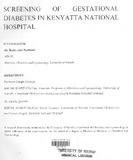| dc.description.abstract | Background: Gestational diabetes is a common medical condition complicating pregnancies worldwide with a global prevalence estimate of 4-14%. Despite this high prevalence, there is still lack of proper screening, diagnostic and management guidelines fo, this condition in spite of the attendant risks to both mother and her unborn baby. There is still a lot of discussion as to the best screening method and even who and when to screen for this
condition.
Objectives: To determine the prevalence of glucose intolerance with screening using the 50g Glucose Challenge Test and of Gestational diabetes by use of the World Health Organization recommended 7Sg Oral Glucose Tolerance Test. Other objectives were to further determine the specificity, sensitivity, positive and negative predictive values of the risk factor screen using the Glucose Challenge Test as a gold standard and to establish correlation of the socio demographic risk factors to Glucose intolerance and Gestational Diabetes Mellitus.
Methods: This was a cross sectional descriptive study. The study was conducted in the antenatal clinic in Kenyatta National Hospital. All eligible and consenting patients were administered a standardized structured precoded questionnaire aimed at establishing risk factors for Gestational Diabetes Mellitus. These clients were then offered a SOg glucose load after which a blood glucose test was done. The clients who screened positive for glucose intolerance by the SOg Glucose Challenge Test were then requested to have repeat 7Sg glucose test which was used as the diagnostic gold standard for diagnosis of Gestational diabetes within 2 weeks after the initial test.
Results: From 371 participants, Using a cut off of 7.2mmol/l for the SOg glucose challenge test, 92 (24.8%) had positive glucose challenge tests and of these 43(11.6 %) were diagnosed as having gestational diabetes by use of the World Health Organization 75g oral glucose tolerance test. With a cut off of 7.8mmol/l for the SOg glucose challenge test then the glucose intolerant population is at 46(12.6%) and that of gestational diabetes is 33(8.9%). The risk factor screening was also noted to have a low sensitivity of 43.49% and specificity of 7S.27% as compared to the SO glucose challenge test screening tool. Factors associated with gestational diabetes were; family history of hypertension, education level, age > 2S yrs of age, presence of glycosuria.
Conclusion: prevalence of glucose intolerance was 24.8% w\lile that of gestational diabetes was 11.6%. Universal screening with 50g glucose challenge test has good sensitivity and specificity as compared to risk factor screening. Significant associations with gestational diabetes were with age greater than 25 years, higher education levels, family history of blood pressure and history of glycosuria.
Recommendations: Considering the high prevalence noted in the study universal screening of glucose intolerance should be done in our setting by use of 50g glucose challenge test, as opposed to targeted screening. The cut off employed for the 50g glucose challenge test should be 7.8mmolll. The timing of the testing should be between 24 -32 weeks. High risk women would benefit from World Health Organization 75g oral glucose tolerance test. | en_US |

